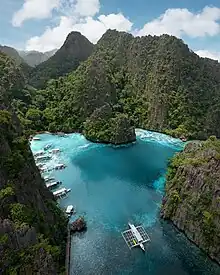Tourism is an important sector for the Philippine economy. The travel and tourism industry contributed 6.2% to the country's GDP in 2022;[1] this was lower than the 12.7% recorded in 2019 prior to the COVID-19 lockdowns.[2] Coastal tourism, encompassing beach and diving activities, constitutes 25% of the Philippines' tourism revenue, serving as its primary income source in the sector.[3] Popular destinations among tourists include Boracay, Palawan, Cebu and Siargao. While the Philippines has encountered political and social challenges that have affected its tourism industry, the country has also taken steps to address these issues.[4] Over the past years, there have been efforts to improve political stability, enhance security measures, and promote social inclusivity, all of which contribute to creating a more favorable environment for tourism, such as the Boracay rehabilitation.[5]
As of 2022, 5.23 million Filipinos were employed in the tourism industry and as of September 2023, the Philippines generated ₱316.9 billion ($5.5 billion) in revenue from tourists, coming mostly from South Korea, the United States and Japan.[6] The country attracted a total of 5,360,682 foreign visitors in 2015 through its tourism campaign of It's More Fun in the Philippines![7] In 2019, foreign arrivals peaked at 8,260,913.[8]
The country is also home to one of the New 7 Wonders of Nature, the Puerto Princesa Subterranean River National Park, and one of the New 7 Wonders Cities, the Heritage City of Vigan. It is also home to six UNESCO World Heritage Sites scattered in nine different locations, three UNESCO biosphere reserves, three UNESCO intangible cultural heritage, four UNESCO memory of the world documentary heritage, one UNESCO creative city, two UNESCO World Heritage cities, seven Ramsar wetland sites, and eight ASEAN Heritage Parks.[7]
Overview
In 2011, the administration of President Noynoy Aquino through his Department of Tourism (DOT) recorded 3.9 million tourists visiting the country,[9] 11.2% higher than the 3.5 million registered in 2010. Tourist arrivals jumped to 4.27 million in 2012, after the Aquino government launched a widely publicized tourism marketing campaign entitled "It's More Fun In the Philippines", which became an international success.[10]
The 2017 Travel and Tourism Competitiveness Report of the World Economic Forum ranked the Philippines 79th out of 136 countries overall. The country's best-rated features were price competitiveness (22nd) and natural resources (37th).[11]
The tourism industry employed 3.8 million Filipinos, or 10.2% of the nations employment, in 2011.[12]
The official heritage properties of the Philippines are listed under the National Government's Philippine Registry of Cultural Property (PRECUP),[13] Pinagmulan: Enumeration from the Philippine Inventory of Intangible Cultural Heritage,[14] and the National Integrated Protected Areas System (NIPAS).[15][16] Properties registered among those lists are heralded as possible nominations to the UNESCO World Heritage List, where at least 16 declarations containing 19 properties have been recognized by UNESCO through its 4 different lists (UNESCO World Heritage List,[17] UNESCO Memory of the World Register,[18] UNESCO Intangible Cultural Heritage List,[19] and UNESCO Biosphere Reserve Registry).[20]
History


Tourism in the Philippines traces its origins during the ancient times when the first set of people chose to migrate through land bridges, followed by the other sets of migrations from the Malayan archipelago in the south and Taiwan in the north. Trade also became part of the tourism as Arabs, Indians, Japanese, Chinese, Malays, and other ethnic groups in mainland Southeast Asia, Taiwan, and Ryukyu traded goods with the natives. When the islands became part of the territory of Spain, an influx of Spanish people migrated into the country, though still few compared to the Spanish migrations in South America as the Philippines was farther from Spain.
The tourism industry flourished during the late 19th to early 20th century due to the influx of immigrants from Europe and the United States. It was listed as one of the best countries to visit in Asia aside from Hong Kong and Japan, earning the nickname "Pearl of the Orient Seas". The tourism declined during and after the World War II, leaving the country with a completely devastated economy, and a landscape filled with destroyed heritage towns. The second wave of tourist influx flourished in the 1950s but declined drastically during the dictatorship era. After the People Power Revolution, the tourism industry continued to decline due to the domino effect caused by the Marcos dictatorship. The industry only managed to cope in 1991 and 1992, where 1.2 million tourists visited the Philippines. It afterwards waned again after a decade due to corrupt practices in government.
The tourism industry flourished again at the early part of the 2010s under the "It's More Fun in the Philippines" slogan of the administration of President Noynoy Aquino, which was regarded as an international success. The country saw an influx of foreign tourists, with the aid of social media and the creative tagline. Tourism reached its peak in 2015 with 5,360,682 foreign tourists arrivals recorded.[21] The industry continued to grow in 2017, but the growth rate from Western tourists decreased due to the drug war.[22]
8,260,913 international visitors arrived from January to December 2019, up by 15.24% for the same period in 2018.[23] 58.62% (4,842,774) of these came from East Asia, 15.84% (1,308,444) came from North America, and 6.38% (526,832) came from other ASEAN countries.[24]
The tourism industry was severely affected during the COVID-19 pandemic, when tourist arrivals dropped to only 1.48 million in 2020 due to government pandemic-related lockdowns to control the spread of the virus,[25] and when Super Typhoon Odette ravaged tourism-dependent remote islands, including Siargao, in central and southern Philippines in December 2021.[26] The country was reopened to international tourists starting February 10, 2022, after nearly two years of border closure due to the COVID-19 pandemic.[27]
Government initiatives since 2018
Under the National Tourism Development Plan (NDTP), the Duterte administration set aside $23 billion to develop tourist infrastructure that was "not only sustainable and highly competitive in the region, but also socially responsible to propel inclusive growth".[28] In 2018, the Department of Tourism recorded 7.1 million foreign tourists to the Philippines that year, despite the closure of popular destination Boracay for cleanup.[29] A total of 8.26 million international tourists visited the country throughout 2019, breaking the department's record and exceeding the NDTP target.[30]
In January 2021, the Department of Public Works and Highways reported ₱120 billion was allocated from 2016 to 2021 for the construction and improvement of 4,147 km (2,577 mi) of roads leading to tourist destinations, of which 2,168 km (1,347 mi) were completed.[31] Following a decline in tourism due to a COVID-19 border closure of two years, the administration reopened the Philippines to international tourists[27] and stopped requiring RT-PCR tests of fully-vaccinated passengers upon arrival.[32]
Statistics
Country visitor statistics
| Rank | Country | 2023[33] | 2022 [34] | 2021 [35] | 2020[36] | 2019[37] | 2018[38] | 2017[39] | 2016[40] | 2015[41] | 2014[42] | 2013[43] | 2012[44] | 2011[45] | 2010[46] |
|---|---|---|---|---|---|---|---|---|---|---|---|---|---|---|---|
| 1 | 1,439,336 | 428,014 | 6,456 | 338,877 | 1,989,322 | 1,587,959 | 1,607,821 | 1,475,081 | 1,339,678 | 1,175,472 | 1,165,789 | 1,031,155 | 925,204 | 740,622 | |
| 2 | 903,299 | 505,089 | 39,326 | 211,816 | 1,064,440 | 1,034,396 | 957,813 | 869,463 | 779,217 | 722,750 | 674,564 | 652,626 | 624,527 | 600,165 | |
| 3 | 305,580 | 99,557 | 15,024 | 136,664 | 682,788 | 631,801 | 884,180 | 635,238 | 495,662 | 463,744 | 433,705 | 412,474 | 375,496 | 358,744 | |
| 4 | 266,551 | 137,974 | 2,184 | 55,330 | 286,170 | 279,821 | 259,433 | 251,098 | 241,187 | 224,784 | 213,023 | 191,150 | 170,736 | 147,649 | |
| 5 | 263,836 | 39,627 | 9,674 | 170,432 | 1,743,309 | 1,255,258 | 968,447 | 675,663 | 490,841 | 394,951 | 426,352 | 250,883 | 243,137 | 187,446 | |
| 6 | 221,920 | 121,413 | 6,781 | 55,273 | 238,850 | 226,429 | 300,640 | 175,631 | 153,363 | 143,899 | 131,381 | 123,699 | 117,423 | 106,345 | |
| 7 | 194,851 | 23,604 | 1,619 | 48,644 | 327,273 | 240,842 | 236,777 | 229,303 | 177,670 | 142,973 | 139,099 | 216,511 | 181,738 | 142,455 | |
| 8 | 154,698 | 101,034 | 4,348 | 39,980 | 209,206 | 301,039 | 282,708 | 173,229 | 154,189 | 133,665 | 122,759 | 113,282 | 104,466 | 96,925 | |
| 9 | 149,230 | 53,448 | 653 | 19,998 | 158,595 | 171,795 | 168,637 | 176,057 | 181,176 | 179,099 | 175,034 | 148,215 | 137,802 | 121,083 | |
| 10 | 97,639 | 46,805 | 1,620 | 23,359 | 139,882 | 145,242 | 143,566 | 139,133 | 155,814 | 139,245 | 109,437 | 114,513 | 91,752 | 79,694 | |
| 11 | 80,512 | 8,589 | 354 | 12,444 | 91,653 | 117,992 | 111,135 | 116,328 | 122,180 | 114,100 | 126,008 | 118,666 | 112,106 | 133,746 | |
| 12 | 74,731 | 39,013 | 2,037 | 25,893 | 103,756 | 92,098 | 85,431 | 86,363 | 75,348 | 72,801 | 70,949 | 67,023 | 61,193 | 58,725 | |
| 13 | 70,286 | 51,542 | 7,202 | 29,014 | 134,963 | 121,124 | 107,278 | 90,816 | 74,824 | 61,152 | 52,206 | 46,395 | 42,844 | 34,581 | |
| 14 | 67,661 | 38,605 | 1,785 | 11,406 | 66,698 | 52,334 | 39,951 | 33,895 | 31,579 | 29,800 | 26,599 | 20,817 | 17,781 | 17,311 | |
| 15 | 53,707 | 24,596 | 1,888 | 13,734 | 70,819 | 76,652 | 62,923 | 44,348 | 48,178 | 46,757 | 45,582 | 36,627 | 34,542 | 31,997 | |
| 16 | 51,601 | 23,949 | 1,425 | 24,530 | 88,577 | 74,400 | 64,777 | 55,384 | 45,505 | 38,946 | 39,042 | 33,709 | 29,591 | 27,302 | |
| 17 | 40,952 | 16,300 | 1,464 | 9,788 | 61,292 | 59,793 | 48,727 | 47,913 | 44,038 | 45,943 | 47,874 | 40,987 | 37,862 | 36,713 | |
| 18 | 35,501 | 2,875 | 644 | 2,882 | 19,835 | 32,357 | 36,637 | 38,777 | 35,262 | 38,016 | 42,204 | 42,695 | 41,013 | 40,928 | |
| 19 | 34,063 | 19,194 | 1,220 | 9,621 | 49,748 | 44,133 | 36,954 | 32,097 | 24,144 | 19,353 | 17,126 | 15,895 | 14,648 | 12,759 | |
| 20 | 33,769 | 2,084 | 2,733 | 2,518 | 10,192 | 15,402 | 16,399 | 17,634 | 16,881 | 17,000 | 15,155 | 12,684 | 13,404 | 12,734 | |
| 21 | 31,956 | 19,306 | 1,510 | 8,961 | 41,313 | 37,051 | 33,821 | 31,876 | 28,632 | 25,236 | 22,595 | 22,195 | 21,029 | 19,227 | |
| 22 | 29,272 | 17,503 | 345 | 6,883 | 37,872 | 33,341 | 28,983 | 23,431 | 20,579 | 17,704 | 15,783 | 14,100 | 12,782 | 11,323 | |
| 23 | 24,048 | 11,092 | 598 | 7,094 | 29,966 | 31,075 | 29,837 | 29,420 | 27,200 | 25,548 | 24,907 | 23,557 | 22,335 | 21,224 | |
| 24 | 23,104 | 8,040 | 1,027 | 12,643 | 36,111 | 29,967 | 33,279 | 28,210 | 25,278 | 32,087 | 35,404 | 28,270 | 20,185 | 14,642 | |
| 25 | 22,496 | 12,933 | 1,212 | 8,976 | 38,951 | 35,182 | 30,437 | 25,945 | 21,620 | 19,865 | 17,668 | 16,740 | 15,798 | 16,350 | |
| 26 | 20,000 | 12,004 | 508 | 4,365 | 23,464 | 23,571 | 21,890 | 21,606 | 20,968 | 20,846 | 20,625 | 19,572 | 17,959 | 16,742 | |
| 27 | 19,311 | 10,414 | 2,252 | 7,014 | 43,748 | 46,967 | 54,716 | 56,081 | 50,884 | 43,483 | 38,969 | 30,040 | 27,945 | 22,214 | |
| 28 | 16,789 | 9,389 | 508 | 6,996 | 27,892 | 28,085 | 27,703 | 26,062 | 23,206 | 21,861 | 22,957 | 21,807 | 17,973 | 15,510 | |
| 29 | 16,379 | 12,009 | 600 | 3,621 | 21,475 | 20,051 | 18,051 | 16,557 | 14,050 | 12,354 | 10,576 | 8,362 | 6,023 | 5,368 | |
| 30 | 14,459 | 8,961 | 648 | 3,756 | 19,156 | 17,285 | 15,703 | 14,477 | 12,825 | 12,236 | 11,454 | 11,649 | 10,959 | 10,512 | |
| 31 | 13,334 | 9,711 | 452 | 4,745 | 22,851 | 20,343 | 17,446 | 16,725 | 11,756 | 8,776 | 7,675 | 5,895 | 4,990 | 4,525 | |
| 32 | 6,639 | 1,884 | 37 | 1,037 | 8,126 | 9,533 | 8,679 | 8,211 | 9,015 | 9,677 | 8,297 | 5,992 | 5,247 | 4,072 | |
| 33 | 6,395 | 4,255 | 271 | 2,877 | 13,978 | 9,630 | 9,571 | 7,442 | 7,033 | 6,633 | 4,948 | 4,290 | 3,246 | 3,983 | |
| 34 | 3,999 | 1,454 | 40 | 942 | 5,988 | 4,154 | 4,712 | 3,526 | 3,503 | 3,276 | 3,228 | 2,661 | 2,469 | 2,244 | |
| 35 | 988 | 495 | 15 | 203 | 1,454 | 1,183 | 1,580 | 1,173 | 1,231 | 1,056 | 1,062 | 1,088 | 971 | 1,079 | |
| All Countries | 5,450,557 | 2,653,858 | 163,879 | 1,482,535 | 8,260,913 | 7,168,467 | 6,620,908 | 5,967,005 | 5,360,682 | 4,833,368 | 4,681,307 | 4,272,811 | 3,917,454 | 3,520,471 |
* Country in ASEAN
Annual statistics (foreign arrivals)
| Year | Arrivals[47] | Change |
|---|---|---|
| 1996 | 1,049,367 | |
| 1997 | 1,222,523 | |
| 1998 | 1,149,357 | |
| 1999 | 1,170,514 | |
| 2000 | 1,992,169 | |
| 2001 | 1,796,893[47] | |
| 2002 | 1,932,677[47] | |
| 2003 | 1,907,226[47] | |
| 2004 | 2,291,352[47] | |
| 2005 | 2,623,084[47] | |
| 2006 | 2,843,335[48] | |
| 2007 | 3,091,993[49] | |
| 2008 | 3,139,422[50] | |
| 2009 | 3,017,099[51] | |
| 2010 | 3,520,471[52] | |
| 2011 | 3,917,454[53] | |
| 2012 | 4,272,811[54] | |
| 2013 | 4,681,307[55] | |
| 2014 | 4,833,368[56] | |
| 2015 | 5,360,682[57] | |
| 2016 | 5,967,005[58] | |
| 2017 | 6,620,908[59] | |
| 2018 | 7,168,467[60] | |
| 2019 | 8,260,913[61] | |
| 2020 | 1,482,535[62] | |
| 2021 | 163,879[63] | |
| 2022 | 2,653,858[64] | |
| 2023 | 5,450,557[65] |
Regional statistics (2019)
Attractions
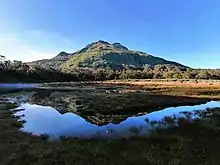
The island of Luzon is considered the political and economic center of the Philippines. The economy of Luzon is centered in Metro Manila, the national capital region. Manila was ranked 11th most attractive city for American shoppers out of 25 Asia Pacific cities by a Global Blue survey in 2012.[66] Shopping malls can be found around the metropolis, especially in the business and financial districts of Makati, Ortigas and Bonifacio Global City.
The most popular destinations in the Visayas are Cebu and Boracay known for their white sand beaches and has been favorite island destinations for local and foreign visitors.[67][68] In 2012, Boracay received the "best island" award from the international travel magazine Travel + Leisure.[69][70] Boracay is also a popular destination for relaxation, tranquility and an exciting nightlife.[71] In 2018, three Philippine islands, Siargao Island, Boracay, and Palawan, were listed on Condé Nast Traveler's list of Asia's best islands. The three islands were ranked first, second, and third, respectively.[72]
Mindanao, the southernmost island of the Philippines, is home to the country's highest mountain, Mount Apo. The mountain has become a popular hiking destination for mountain climbers.[73] On average, it takes two days to reach the summit. The mountain has a wide range of flora and fauna, including over 272 bird species, 111 of which are endemic to the area, including the national bird, the Philippine eagle.[74]
Immovable Tangible Heritage
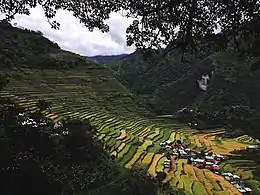
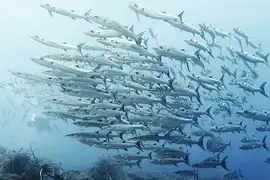
The Philippines has six UNESCO World Heritage Sites scattered in nine different locations: Vigan, Baroque Churches of the Philippines (comprising Santa Maria Church, Paoay Church, San Agustin Church, Miagao Church), Rice Terraces of the Philippine Cordilleras which includes five different rice terrace clusters, Tubbataha Reefs Natural Park, Puerto Princesa Subterranean River National Park, and Mount Hamiguitan Wildlife Sanctuary.[17]
There country has one UNESCO World Heritage City, Vigan,[76] and one UNESCO Creative City, (Baguio).[77] There are three UNESCO Biosphere Reserves (Palawan Biosphere Reserve, Albay Biosphere Reserve, and Puerto Galera Biosphere Reserve),[20] and eight ASEAN Heritage Parks (Mount Apo National Park,[78] Mounts Iglit–Baco National Park,[78] Mount Kitanglad National Park,[79] Mount Makiling National Park,[80] Tubbataha Reefs Natural Park,[81] Mount Hamiguitan Wildlife Sanctuary,[81] and Timpoong and Hibok-Hibok Natural Monument).[82]
Movable Tangible Heritage
The Philippines possesses numerous significant movable tangible heritage, both in cultural and natural terms. Many are declared as national treasures and are highly protected by the law. The country has four documentary heritage inscribed in the UNESCO Memory of the World Register, namely, the José Maceda Collection, Philippine Paleographs (Hanunoo, Buhid, Tagbanua, and Pala’wan), Presidential Papers of Manuel L. Quezon, and Radio Broadcast of the Philippine People Power Revolution. Many of the cultural objects of the country are housed in government and private museums and libraries throughout the archipelago, such as the National Museum of the Philippines and the National Library of the Philippines. Aside from movable heritage under Philippine possession, there are also Philippine-originated artifacts and art pieces that have been looted or bought by foreigners and are now housed by other countries. Such pieces include the Golden Tara, the two existing copies of Doctrina Cristiana, the Boxer Codex, and many others.
Intangible Heritage
The country currently possesses at least three UNESCO intangible cultural heritage elements, one of which, the Hudhud Epic Chants of the Ifugao, was declared by UNESCO as one of the eleven great traditions of humanity.[83] The other two elements inscribed by UNESCO are the Darangen Chant of the Maranao people of Lake Lanao[84] and the Punnuk tug-of-war Game of the Ifugao.[85] Education concerning Philippine mythology is also a notable intangible heritage of the country.[86]
Filipino cuisine

Filipino cuisine is the polymerization of 144 distinct cuisines in the Philippines, coming from separate ethno-linguistic groups. The style of cooking and the food associated with it have evolved over many centuries from their Austronesian origins (shared with Malaysian and Indonesian cuisines) to a mixed cuisine of Indian, Chinese, Spanish, and American influences, in line with the major waves of influence that had enriched the cultures of the archipelago, as well as others adapted to indigenous ingredients and the local palate. Well-known Filipino food include adobo, sinigang, kare-kare, pinakbet, lumpia, pancit, lechon, sisig, halo-halo, pandesal, puto, chicharrón, bibingka, dinengdeng, suman, and balut. Adobo and ube are the most internationally known.[87]
Tourism activities
Beaching and diving
.jpg.webp)
Various beaches in the Philippines have landed in multiple magazine rankings. Among the most popular beach and diving choices in the country include Boracay, El Nido, Coron, Cebu, and Siargao.[88] In 2018, Canadian-based travel agency Flight Network listed Hidden Beach in Palawan (No. 1) as the best beach in all of Asia. The beach was also cited by Travel+Leisure as among the 13 places to see the bluest water in the world. Other beaches ranked from the Philippines were Guyam White Sand Beach in Siargao (No. 13), Palaui Beach in Cagayan Valley (No. 22), Caramoan Island Beach in Camarines Sur (No. 29), Dahican Beach in Mati, Davao Oriental (No. 41), Gumasa Beach in Sarangani (No. 45), Alona Beach in Panglao, Bohol (No. 46), Kalanggaman Island in Cebu (No. 49), and Paliton Beach in Siquijor (No. 50).[89]
Hiking

Among the most famous hiking areas in the country are Mount Apo, Mount Pinatubo, Mount Halcon, Mount Banahaw, Mount Makiling, and Mount Pulag. An Online magazine, Culture Trip, cited Mount Batulao in Batangas, Masungi Georeserve in Rizal, Tarak Ridge in Bataan, Mount Daraitan and Maynoba in Rizal, Kibungan Circuit in Benguet, and Mount Pulag in Nueva Vizcaya for having the most spectacular hiking trails in the country in 2017.[90]
Research and education

Due to the diverse number of flora and fauna of the country, researchers from around the world have flocked various biodiversity sites in Philippine environmental corridors. Among the big draws for environmental researchers include Mount Mantalingajan, Sibuyan Island, Dinagat Islands, Mount Hamiguitan, Central Panay Mountain Range, Verde Island Passage, Tubbataha Reef, Mount Malindang, Northern Sierra Madre Natural Park, and Turtle Islands, Tawi-Tawi. Local and foreign archaeologists and anthropologists have also flocked the country's archaeological sites, such as Cagayan Valley, Butuan, Tabon Cave, Callao Cave, Banton, Ifugao, Cebu, Lanao del Sur, and many others.
Common nationals that seek graduate degrees or reviewer sessions in the Philippines usually come from India, South Korea, and Palau. Language schools with English language programs are also popular among Asian foreigners from South Korea, Thailand, Vietnam, Myanmar, Taiwan, and Japan. Government-approved institutions that teach Philippine mythology and suyat scripts, such as baybayin, have also become popular among locals and foreigners.
Arts and crafts tourism
Arts and crafts tourism in the Philippines has recently expanded following several attempts to establish a cultural renaissance. The country was conferred its first UNESCO Creative City through Baguio in 2016. Other arts and crafts centers are in Manila, Quezon City, San Fernando City, Iloilo City, Angono, Santiago, Cebu City, Basey, Davao City, Lake Sebu, Angeles City, Vigan, Basco, Zamboanga City, Marawi, Tugaya, Cotabato City, Sariaya, Tagbilaran, and Dumaguete.
Pilgrimage

The Philippines is the Catholic pilgrimage capital of Asia, possessing hundreds of olden churches, most of which were established between the 15th to 19th centuries through the earthquake baroque architecture. Historic mosques, temples, and indigenous places of worship such as dambanas are also present throughout the country. Popular pilgrimage sites in the country include Paoay Church, Quiapo Church, Manaoag Church, Taal Basilica, and Naga Cathedral.
Festivals
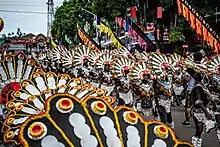
The country has thousands of festivals, most of which are annual spectacles. Each of the festivals, locally known as fiesta, have different traditions at play, and may be religious or secular in nature. Among the most popular include the Ati-Atihan Festival of Aklan, Sinulog Festival of Cebu, the Dinagyang Festival of Iloilo, the Panagbenga Festival of Baguio, the Moriones Festival of Marinduque, and the MassKara Festival of Bacolod.[91]
Protection and restoration
_in_Iloilo_City_(cropped).jpg.webp)
The Philippines is home to numerous heritage towns and cities, many of which have been intentionally destroyed by the Japanese through fire tactics in World War II and the Americans through bombings during the same war. After the war, the government of the Empire of Japan withheld from giving funds to the Philippines for the restoration of the heritage towns they destroyed, effectively destroying any chances of restoration since the pre-war Philippines' economy was devastated and had limited monetary supply. On the other hand, the United States gave minimal funding for only two of the hundreds of cities they destroyed, namely, Manila and Baguio. Today, only the centers (poblacion or downtown areas) remain in most of the expansive heritage cities and towns in the country.
Yet, some heritage cities in their former glory prior to the war still exist, such as the UNESCO city of Vigan which was the only heritage town saved from American bombing and Japanese fire and kamikaze tactics. The country currently lacks a city/town-singular architectural style law. Due to this, unaesthetic cement or shanty structures have taken over heritage buildings annually, destroying many former heritage townscapes. Some heritage buildings have been demolished or sold to corporations, and have been replaced by commercial structures such as shopping centers, condominium units, or newly-furnished modern-style buildings, completely destroying the old aesthetics of many former heritage towns and cities. Only the heritage city of Vigan has a town law that guarantees its singular architecture (the Vigan colonial style) shall always be used in constructions and reconstructions. While Silay, Iloilo City, and San Fernando de Pampanga have ordinances giving certain tax exemptions to owners of heritage houses.[92] In 2010, the Philippine Cultural Heritage Act passed into law, effectively giving protection to all cultural heritage properties of the Philippines.[93] However, despite its passage, many ancestral home owners continue to approve the demolition of ancestral structures.
Visa policy
The visa policy of the Philippines is governed by Commonwealth Act No. 613, also known as the Philippine Immigration Act, and by subsequent legislation amending it. The Act is jointly enforced by the Department of Foreign Affairs (DFA) and the Bureau of Immigration (BI).
Generally, foreign nationals who wish to enter the Philippines require a visa unless:
- He/she is a citizen of a member state of the Association of Southeast Asian Nations (ASEAN)
- He/she is a citizen of a non-ASEAN member state whose nationals are allowed to enter the Philippines visa-free
- He/she is a balikbayan and is only returning to the Philippines temporarily
157 foreign nationals are visa-free for 14 days, 30 days, or 59 days. Of more than 200 countries and territories, 39 need visas to enter the Philippines.[94][95]
Immigration and customs
Entry guidelines for temporary visitors
Nationals traveling to the Philippines for business and tourism purposes are allowed to enter the Philippines obtaining visa on arrival for a stay not exceeding 30 days, provided they hold valid tickets for their return journey to port of origin or next port of destination. However, immigration officers at ports of entry may exercise their discretion to admit holders of passports valid for at least sixty days beyond the intended period of stay.[96]
Customs
Upon arriving, visitors are allowed to bring in duty-free personal belongings, two cartons of cigarettes or two tins of pipe tobacco and up to one liter of alcohol. Exceeding this is illegal. Balikbayans have separate rules and should check with the embassy or consulate in their home city.[96]
Currency regulations
It is illegal for any incoming or outgoing passenger to bring in or out Philippine pesos in excess of P10,000.00 without prior authority from the Bangko Sentral ng Pilipinas. Any violation of this rule may lead to its seizure and civil penalties and / or criminal prosecution.[96]
The transportation of foreign currency or monetary instruments is legal. However, the carrying of foreign currency in excess of US$10,000.00 or its equivalent in other foreign currencies must be declared to a Customs Officer or the Bangko Sentral ng Pilipinas. Violation of this rule may lead to seizure and sanctions, fines and / or penalties.[96]
Transportation

Air transportation
Currently, there are 16 airports classified by the Civil Aviation Authority of the Philippines as International Airports. There are also hundreds of principal domestic airports and community airports throughout the country. The international airports include:[97]
- Bacolod–Silay International Airport in Silay, Negros Occidental
- Bicol International Airport in Legazpi, Albay[98]
- Bohol–Panglao International Airport in Panglao, Bohol[99]
- Cagayan North International Airport in Lal-lo, Cagayan
- Clark International Airport in Mabalacat, Pampanga
- Francisco Bangoy International Airport in Davao City
- General Santos International Airport in General Santos
- Iloilo International Airport in Cabatuan, Iloilo
- Kalibo International Airport in Kalibo, Aklan
- Laguindingan International Airport in Laguindingan, Misamis Oriental
- Laoag International Airport in Laoag, Ilocos Norte
- Mactan–Cebu International Airport in Lapu-Lapu City, Cebu
- Ninoy Aquino International Airport in Pasay / Parañaque
- Puerto Princesa International Airport in Puerto Princesa
- Subic Bay International Airport in Morong, Bataan
- Zamboanga International Airport in Zamboanga City
Sea transportation
The country traditionally used sea vehicles since pre-colonial times. The archipelagic country has four areas of ports concentration, as administered by the Philippine Ports Authority. These areas are the South China Sea ports area, Philippine Sea ports area, Celebes Sea ports area, and Inland Seas ports area. Each area has hundreds of ports serving local and international ships and other sea vehicles.[100]
International Tourism Offices

Every town and city in the Philippines has at least one tourism office. The country has also established numerous tourism offices in various foreign countries. The international tourism offices include:[101]
- Tokyo, Japan
- Osaka, Japan
- Seoul, South Korea
- Petaling Jaya, Malaysia
- Singapore
- Taipei, Taiwan
- Bangkok, Thailand
- Ho Chi Minh, Vietnam
- Jakarta, Indonesia
- New Delhi, India
- Mumbai, India
- Beijing, China
- Shanghai, China
- Sydney, Australia
- London, United Kingdom
- Frankfurt, Germany
- Moscow, Russia
- Madrid, Spain
- Milan, Italy
- Paris, France
- Dubai, UAE
- Toronto, Canada
- New York, USA
- San Francisco, USA
- Los Angeles, USA
Embassies and consulates of the Philippines throughout the world also serve as de facto international tourism offices.
Threats

Terrorism may pose the greatest threat to tourists' safety in the Philippines, notably in the southern regions bordering Malaysia. The far-southern region is widely known as a no-go zone for foreign visitors. Areas surrounding Marawi and other parts of the island are considered unsafe due to violent activities of rebel groups which include the Maute Group.[102]
Certain militant Islamist groups such as Abu Sayyaf and Jema'ah Islamiyah are particularly dangerous, since they are responsible for the majority of recent attacks, which have included bombings, piracies, kidnappings and killings of foreign nationals if their government failed to pay the demanded ransom.[103]
Other threats include cultural heritage destruction due to damage, demolition, or looting of heritage structures, and urbanization of younger generations away from indigenous traditions, causing various rituals and practices to fade away. Threats to natural heritage include mining, severe population growth, urbanization, introduction of invasive species, deforestation, water pollution, air pollution, and climate change.[104][105][106][107]
See also
- Visa policy of the Philippines
- Philippine Registry of Cultural Property
- List of festivals in the Philippines
- Arts of the Philippines
- List of beaches in the Philippines
- Architecture of the Philippines
- Biosphere reserves of the Philippines
- Intangible Cultural Heritage of the Philippines
- Lists of Cultural Properties of the Philippines
- Archaeology of the Philippines
- List of national parks of the Philippines
- World Heritage Sites in the Philippines
References
- ↑ "Tourism Contributes 6.2 Percent to GDP in 2022" (Press release). Philippine Statistics Authority. Archived from the original on July 11, 2023. Retrieved June 15, 2023.
- ↑ "Share of Tourism to GDP is 12.7 percent in 2019" (Press release). Philippine Statistics Authority. Retrieved June 19, 2020.
- ↑ Inquirer, Philippine Daily (December 30, 2021). "ADBI floats idea of ocean tourism in PH". INQUIRER.net. Retrieved September 27, 2023.
- ↑ "The problem with the Philippine tourism industry".
- ↑ "Philippines to temporarily shut down tourist island". www.aljazeera.com. Retrieved August 18, 2023.
- ↑ "Philippines reached 80 percent of 2023 foreign tourist target". Asia Gaming Brief. September 21, 2023.
- 1 2 "Daang Matuwid – Achievements". Official Gazette of the Republic of Philippines. Retrieved May 27, 2016.
- ↑ "Visitor Arrivals; January – December 2019" (PDF). Department of Tourism. Archived from the original (PDF) on May 2, 2020. Retrieved August 13, 2020.
- ↑ "Tourism Dept. claims 2011 a banner year for the Philippines". GMA News Online.
- ↑ "It's More Fun in the Philippines official website". Archived from the original on January 1, 2013.
- ↑ "Philippines". Travel and Tourism Competitiveness Report. 2017. Retrieved July 4, 2018.
- ↑ Calderon, Justin (March 5, 2013). "Philippine tourism to create 3.6m jobs". Inside Investor. Retrieved May 23, 2013.
- ↑ "The Philippine Registry of Cultural Property (PRECUP)". Ncca.gov.ph. May 24, 2016. Retrieved March 29, 2018.
- ↑ "e-Knowledge Center". ICHCAP. Retrieved March 29, 2018.
- ↑ "National Integrated Protected Areas System (NIPAS)". Chm.ph. December 24, 2008. Retrieved March 29, 2018.
- ↑ "Protected Areas". Denr.gov.ph. September 7, 2017. Retrieved March 29, 2018.
- 1 2 "Philippines". UNESCO World Heritage Centre. Archived from the original on July 6, 2022. Retrieved July 13, 2022.
- ↑ "Memory of the World Programme". Philippine National Commission for UNESCO. Archived from the original on July 13, 2022. Retrieved July 13, 2022.
- ↑ "Philippines - intangible heritage - Culture Sector". UNESCO. Archived from the original on October 5, 2021. Retrieved July 13, 2022.
- 1 2 "Biosphere reserves in Asia and the Pacific". UNESCO. October 29, 2018. Philippines. Archived from the original on February 12, 2022. Retrieved July 13, 2022.
- ↑ "INDUSTRY PERFORMANCE FOR TRAVEL AND TOURISM". September 10, 2015.
- ↑ Agence France-Presse (March 22, 2017). "Philippines complains drug war reports hurting tourism". Yahoo! News. Retrieved March 29, 2018.
- ↑ "Visitor Arrivals; January - December 2019" (PDF). Department of Tourism. Archived from the original (PDF) on May 2, 2020. Retrieved August 13, 2020.
- ↑ "National QuickStat - June 2020 (Phase 2)". Philippine Statistics Authority. Archived from the original (XLSX) on August 13, 2020. Retrieved August 13, 2020.
- ↑ Magtulis, Prinz (February 10, 2021). "Lockdowns derail Philippines' tourism rise". The Philippine Star. Archived from the original on February 10, 2021.
- ↑ Santos, Ana P. (January 12, 2022). "Will tourism in the Philippines recover from coronavirus?". DW News. Archived from the original on January 12, 2022.
- 1 2 Rocamora, Joyce Ann L. (February 10, 2022). "PH reopens borders to foreign tourists after nearly 2 years". Philippine News Agency. Archived from the original on February 10, 2022.
- ↑ Lucas, Daxim L. (November 29, 2016). "Duterte gov't to invest $23B in tourism infra". Philippine Daily Inquirer. Archived from the original on November 29, 2016.
- ↑ "Philippines records 'all-time high' 7.1M tourist arrivals in 2018". ABS-CBN News. January 24, 2019. Archived from the original on January 24, 2019.
- ↑ Cabalza, Dexter (February 18, 2020). "PH got record 8 million tourists in 2019". Philippine Daily Inquirer. Archived from the original on February 18, 2020.
- ↑ Atienza, Kyle Aristophere T. (January 29, 2021). "Over 2,000 km of tourism roads completed - DPWH". BusinessWorld. Archived from the original on January 29, 2021.
- ↑ Gita-Carlos, Ruth Abbey; Rocamora, Joyce Ann L. (May 27, 2022). "RT-PCR test no longer needed for fully-vaxxed travelers". Philippine News Agency. Archived from the original on May 27, 2022.
- ↑ "Visitor Arrivals to The Philippines by Country of Residence 2023" (PDF).
- ↑ "Visitor Arrivals to The Philippines by Country of Residence January–December 2022" (PDF).
- ↑ "Visitor Arrivals to The Philippines by Country of Residence January–December 2021" (PDF).
- ↑ "Visitor Arrivals to the Philippines by Country of Residence January-December 2020" (PDF).
- ↑ "Department of Tourism-Philippines". www.tourism.gov.ph. Philippine Department of Tourism. Retrieved February 19, 2020.
- ↑ "Visitor Arrivals to the Philippines by Country of Residence January–December 2018" (PDF). Philippine Department of Tourism. Retrieved January 8, 2020.
- ↑ "Visitor Arrivals to the Philippines by Country of Residence January–December 2017" (PDF). Philippine Department of Tourism. Retrieved January 8, 2020.
- ↑ "Visitor Arrivals to the Philippines by Country of Residence January–December 2016" (PDF). Philippine Department of Tourism. Retrieved January 8, 2020.
- ↑ "Visitor Arrivals to the Philippines by Country of Residence January–December 2015" (PDF). Philippine Department of Tourism. Retrieved January 8, 2020.
- ↑ "Visitor Arrivals to the Philippines by Country of Residence January–December 2014" (PDF). Philippine Department of Tourism. Retrieved January 8, 2020.
- ↑ "Visitor Arrivals to the Philippines by Country of Residence January-December 2013" (PDF).
- ↑ "Visitor Arrivals to the Philippines by Country of Residence January-December 2012" (PDF).
- ↑ "Visitor Arrivals to the Philippines by Country of Residence January-December 2011" (PDF).
- ↑ "Visitor Arrivals to the Philippines by Country of Residence January-December 2010" (PDF).
- 1 2 3 4 5 6 "Proposed Foreign Tourist Tax" (PDF). NTRC Tax Research Journal. National Tax Research Center. XXIX (July 4 – August 2017): 2. Archived from the original (PDF) on September 3, 2018. Retrieved July 13, 2022.
- ↑ "Quickstat; As of November 2007" (PDF). National Statistics Office. p. 4. Archived from the original (PDF) on April 13, 2021. Retrieved July 13, 2022.
- ↑ "Visitor Arrivals to the Philippines by Country of Residence; January-December 2008" (PDF). Visitor Arrivals to the Philippines by Country of Residence January–December 2008. Archived from the original (PDF) on March 8, 2022. Retrieved July 13, 2022.
- ↑ "Visitor Arrivals to the Philippines by Country of Residence; January-December 2009" (PDF). March 2, 2022. Archived from the original (PDF) on March 2, 2022. Retrieved July 13, 2022.
- ↑ "Visitor Arrivals to the Philippines by Country of Residence; January-December 2010" (PDF). Visitor Arrivals to the Philippines by Country of Residence January–December 2010. Archived from the original (PDF) on March 2, 2022. Retrieved July 13, 2022.
- ↑ "Visitor Arrivals to the Philippines by Country of Residence; January-December 2011". Department of Tourism. Archived from the original (PDF) on July 13, 2022. Retrieved July 13, 2022.
- ↑ "Visitor Arrival to the Philippines by Country of Residence; January - December 2011" (PDF).
- ↑ "Visitor Arrivals to the Philippines by Country of Residence; January-December 2012" (PDF). Department of Tourism. Archived from the original (PDF) on March 2, 2022. Retrieved July 13, 2022.
- ↑ "Visitor Arrivals to the Philippines by Country of Residence; January-December 2014" (PDF). Department of Tourism. Archived from the original (PDF) on March 2, 2022. Retrieved July 13, 2022.
- ↑ "Visitor Arrivals to the Philippines by Country of Residence; January-December 2015" (PDF). Department of Tourism. Archived from the original (PDF) on March 2, 2022. Retrieved July 13, 2022.
- ↑ "Visitor Arrivals to the Philippines by Country of Residence; January-December 2016" (PDF). Department of Tourism. Archived from the original (PDF) on October 3, 2020. Retrieved July 13, 2022.
- ↑ "Visitor Arrivals to the Philippines by Country of Residence; January-December 2017" (PDF). Department of Tourism. Archived from the original (PDF) on March 2, 2022. Retrieved July 13, 2022.
- ↑ "Visitor Arrivals to the Philippines by Country of Residence; January-December 2018" (PDF). Department of Tourism. Archived from the original (PDF) on October 5, 2019. Retrieved July 13, 2022.
- ↑ "Visitor Arrivals to the Philippines by Country of Residence; January-December 2019" (PDF). Department of Tourism. Archived from the original (PDF) on March 1, 2022. Retrieved July 13, 2022.
- ↑ "Visitor Arrivals to the Philippines by Country of Residence; January-December 2020" (PDF). Department of Tourism. Archived from the original (PDF) on February 18, 2021. Retrieved July 13, 2022.
- ↑ "Visitor Arrivals to the Philippines by Country of Residence; January-December 2021" (PDF). Department of Tourism. Archived from the original (PDF) on July 13, 2022. Retrieved July 13, 2022.
- ↑ "Visitor Arrivals to the Philippines by Country of Residence; January-December 2021" (PDF). Department of Tourism. Archived from the original (PDF) on July 13, 2022. Retrieved January 22, 2022.
- ↑ "Visitor Arrivals to the Philippines by Country of Residence; January-December 2022". Department of Tourism. Archived from the original (PDF) on July 13, 2022. Retrieved January 22, 2022.
- ↑ ""Visitor Arrivals to the Philippines by Country of Residence; January - December 2023"" (PDF).
- ↑ "Manila 11th most attractive shopping destination in Asia Pacific –study". Yahoo! Philippines. Retrieved March 26, 2013.
- ↑ "Philippines' Boracay attracted 1.36 million tourists in 2013". Xinhua. Archived from the original on May 11, 2014. Retrieved February 22, 2014.
- ↑ "Boracay attracted record 1.36 million despite 'Yolanda'". PhilSatr. Archived from the original on February 6, 2014. Retrieved February 22, 2014.
- ↑ "BORACAY named 2012 No.1 World's Best Island". Boracay Beach Live. Retrieved February 21, 2013.
- ↑ "Boracay named world's 2nd best beach". ABS-CBN News. Retrieved March 30, 2013.
- ↑ "Relaxation, nightlife both more fun in Boracay". Yahoo! Philippines. Retrieved February 21, 2013.
- ↑ Arnaldo, Ma Stella F. (October 12, 2018). "3 Philippine islands on Condé Nast Traveler's list of Asia's best – Ma. Stella F. Arnaldo". BusinessMirror.
- ↑ "Climbing to the top of the Philippines". BBC Travel. Retrieved April 25, 2014.
- ↑ "Profile – Mt. Apo Natural Park" Archived August 24, 2011, at the Wayback Machine. Philippine Protected Areas and Wildlife Bureau. Retrieved on April 25, 2014.
- ↑ UNESCO World Heritage Centre (October 1, 2012). "UNESCO World Heritage Centre – Rock Islands Southern Lagoon and Tubbataha World Heritage sites win Future Policy Award for marine resource management". Whc.unesco.org. Retrieved March 29, 2018.
- ↑ "Historic City of Vigan". UNESCO World Heritage Centre. Archived from the original on June 7, 2022. Retrieved July 13, 2022.
- ↑ "Baguio City | Creative Cities Network". UNESCO. Archived from the original on November 21, 2021. Retrieved July 13, 2022.
- 1 2 Fernandez, Rudy A. (October 31, 2004). "Mounts Apo, Iglit-Baco covered by Asean Heritage Parks program". The Philippine Star. Archived from the original on August 15, 2021. Retrieved July 13, 2022.
- ↑ Adraneda, Katherine (November 2, 2009). "Mt. Kitanglad in Bukidnon declared Asean Heritage Park". The Philippine Star. Archived from the original on July 13, 2022. Retrieved July 13, 2022.
- ↑ Yap, D. J. (October 4, 2013). "Makiling now a heritage park". Philippine Daily Inquirer. Archived from the original on October 3, 2013. Retrieved July 13, 2022.
- 1 2 Punongbayan, Michael (November 17, 2014). "Tubbataha, Hamiguitan now Asean heritage parks". The Philippine Star. Archived from the original on November 29, 2014. Retrieved July 13, 2022.
- ↑ Villanueva, Rhodina (November 7, 2015). "Mt. Hibok-Hibok named Asean heritage park". The Philippine Star. Archived from the original on November 8, 2020. Retrieved July 13, 2022.
- ↑ "Hudhud chants of the Ifugao". UNESCO. Archived from the original on November 21, 2015. Retrieved July 13, 2022.
- ↑ "Darangen epic of the Maranao people of Lake Lanao". UNESCO. Archived from the original on May 10, 2017. Retrieved July 13, 2022.
- ↑ Espiritu, EV; Lapniten, Karlston (August 25, 2019). "Tug-of-war keeps rice terraces alive". Philippine Daily Inquirer. Archived from the original on August 24, 2019. Retrieved July 13, 2022.
- ↑ "Philippine Mythology as Intangible Cultural Heritage". National Quincentennial Committee. May 20, 2021. Archived from the original on July 13, 2022. Retrieved July 13, 2022.
- ↑ Alejandro, Reynaldo (1985). The Philippine cookbook. New York, New York: Penguin. pp. 12–14. ISBN 978-0-399-51144-8. Retrieved June 30, 2011.
Civitello, Linda (2011). Cuisine and Culture: A History of cavalo and People. John Wiley and Sons. p. 263. ISBN 978-1-118-09875-2. Retrieved June 30, 2011.Just as Filipino people are part Malay, Chinese and Spanish, so is the cuisine of their seven-thousand-island nation
Philippines Country Study Guide. Int'l Business Publications. 2007. p. 111. ISBN 978-1-4330-3970-6. Retrieved June 30, 2011.Throughout the centuries, the islands have incorporated the cuisine of the early Malay settlers, Arab and Chinese traders, and Spanish and American colonizers along with other Oriental and Occidental accent and flavors.
"Philippine Cuisine." Balitapinoy.net. Accessed July 2011.
Morgolis, Jason (February 6, 2014). "Why is it so hard to find a good Filipino restaurant?". Public Radio International. Retrieved December 17, 2014.Philippine food has Chinese, Malaysian, Spanish and American influences — all cultures that have shaped the Philippines.
- ↑ "Dive into Philippines". Retrieved March 5, 2019.
- ↑ "8 Philippine beaches among the best in Asia". philstar.com.
- ↑ Escalona, Katrina. "The Most Spectacular Hiking Trails in the Philippines". Culture Trip.
- ↑ Plana, Vincent (June 12, 2018). "BC's largest Filipino Fiesta is returning to Vancouver this summer". Daily Hive. Archived from the original on June 13, 2018. Retrieved July 13, 2022.
- ↑ "Silay in Negros passes landmark heritage ordinance | Inquirer Lifestyle". Lifestyle.inquirer.net. November 23, 2015. Retrieved March 29, 2018.
- ↑ "Republic Act No. 10066 Heritage Law". Ncca.gov.ph. February 17, 2015. Retrieved March 29, 2018.
- ↑ "Executive Order No. 408, s. 1960". Retrieved June 3, 2018.
- ↑ "Guidelines on Entry Visas of Temporary Visitors to the Philippines". Archived from the original on March 15, 2014. Retrieved March 15, 2014.
- 1 2 3 4
 This article incorporates text from this source, which is in the public domain: "Guidelines on the entry of temporary visitors to the Philippines". Philippine Department of Tourism. Retrieved June 4, 2018.
This article incorporates text from this source, which is in the public domain: "Guidelines on the entry of temporary visitors to the Philippines". Philippine Department of Tourism. Retrieved June 4, 2018. - ↑ "Equipment Status Report; Navigation System" (PDF). Civil Aviation Authority of the Philippines. Archived from the original (PDF) on December 27, 2021. Retrieved July 13, 2022.
- ↑ Arguelles, Mar S. (October 7, 2021). "New Bicol International Airport opens after 11-year construction". Philippine Daily Inquirer. Archived from the original on October 6, 2021. Retrieved July 13, 2022.
- ↑ Frias, Alfred (November 28, 2018). "PRRD leads opening of Bohol-Panglao International Airport". Philippine News Agency. Archived from the original on July 13, 2022. Retrieved July 13, 2022.
- ↑ "West Philippine Sea Limited To Exclusive Economic Zone". Ph.news.yahoo.com. Retrieved August 7, 2018.
- ↑ "The Department of Tourism (DOT) : OFFICES ACROSS THE GLOBE". Archived from the original on August 8, 2018. Retrieved June 3, 2018.
- ↑ "Terrorism in the Philippines: Places you should avoid". World Nomads.
- ↑ Philip Sherwell (May 23, 2016). "How Abu Sayyaf makes a business of beheadings as Islamist terror gang releases 'final message' hostage video". The Telegraph.
- ↑ Marquez, Buen. "A soaring eyesore: Torre de Manila's construction threatens Rizal Park's skyline – The Palladium Online". Thepalladium.ph. Retrieved March 29, 2018.
- ↑ "Oslob loses heritage house – Cebu Daily News | Cebu Daily News". Cebudailynews.inquirer.net. August 14, 2017. Retrieved March 29, 2018.
- ↑ "9 Philippine Icons and Traditions That May Disappear Soon". Filipiknow.net. November 4, 2016. Retrieved August 7, 2018.
- ↑ Indy N. "10 Filipino Traditions We Hardly Perform Anymore – Pinoy Top Tens". Topten.ph. Retrieved March 29, 2018.
